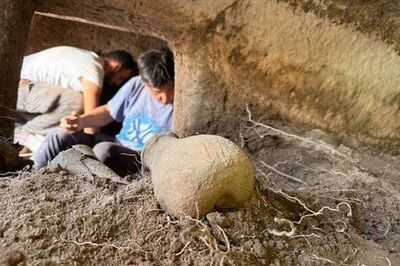Archaeologists have been left amazed after unearthing three ancient "fairy houses" in pristine condition on a Sardinian hillside.
Excavations on the Italian island revealed the extraordinary 5,000 year old chambers, known locally as domus de janas, or "fairy houses", alongside numerous artefacts in "excellent condition", according to the Superintendency of Archaeology, Fine Arts and Landscape for the Provinces of Sassari and Nuoro.
Despite their folkloric name rooted in Sardinian tradition, these structures weren't home to magical creatures.
- Hand-sized spider that eats fish spotted in UK homes after nearly going extinct
- Women realise smart hack means you don't need makeup but there's one big catch
Only 17 of these primitive-looking stone formations from the late Neolithic period and Copper Age had been found prior to this latest find.
The superintendency explained "this new discovery enriches knowledge of the domus de janas - tombs carved into rock that often reproduce, in relief, details of the houses of the living and symbolic decorations linked to magical-religious rituals.", reports the Express.

Local legends claim that fairies and otherworldly beings once inhabited these structures.
Yet archaeologists have determined through discovering bones and human remains that these were actually ancient burial grounds.
The location also contained more than 30 Roman-era pottery fragments, including plates, oil lamps and jugs.
Officials described all the discoveries as being "in excellent condition."
The burial sites were pinpointed by examining the different terrain characteristics between existing tombs and burial sites in the area, suggesting potential underground structures yet to be unearthed.
The diggings unveiled a fan-shaped layout of three chambers branching out from an existing structure known as the Tomb of the Hearth. These "fairy houses" form part of the Sant'Andrea Priu archaeological site, recently recognised as a UNESCO World Heritage Site.
The Mediterranean island, located south of Corsica, is famed for both its coastal allure and archaeological heritage. Archaeologists discovered stone tools including pickaxes and a miniature greenstone axe, along with a spindle whorl - a weighted object fitted to a spindle to maintain its rotation speed - used in textile production.
Shards of obsidian and ceramic were scattered across the sites. The chamber named the Tomb of the Roman Vases yielded particularly rich finds, boasting decorative painted bands on its walls.
This particular tomb held over thirty ceramic items from the Roman era, including oil lamps, serving plates and liquid vessels, showcasing highly advanced stone-carving techniques from over five thousand years ago. The structures' designs often included symbolic elements linked to the religious or ritualistic practices of Neolithic and Copper Age communities.
You may also like

Ola engineer ends life in Bengaluru, case filed against Bhavish Agarwal

Dembele returns to PSG squad for Champions League clash against Leverkusen

Punjab: Man kills mother by slitting throat

Ex-Chelsea boss Graham Potter lands new job just 23 days after West Ham sacking

Stay Alert! How Fake Call Centres Are Tricking People Across India






